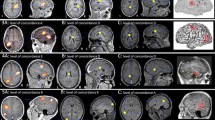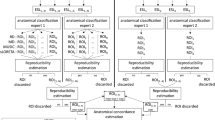Summary
This study includes 11 patients (3 males, 8 females) with mean age of 29 years (range: 15–42 years) who underwent a presurgical evaluation for refractory complex partial seizures (CPS). In all patients, neuroimaging (1.5 T optimum-MR) demonstrated intracranial structural abnormalities (space-occupying: n = 2; atrophic: n = 8; dysplastic: n = 1) and video-EEG monitoring showed CPS. Because of discrepancies in the non-invasive examinations, all underwent additional intracranial EEG monitoring. After tailored resective procedures, all but one patient became seizure free. Mean follow-up was 30 months (range: 12–52 months). Results of intracranial EEG recording were compared with spatiotemporal dipole mapping of interictal and ictal epileptic discharges. Interictal dipole modelling revealed two distinct dipole patterns. Patients with lesions located in the medial temporal lobe uniformly presented a combined dipole that consisted of a radial and a tangential component with a high degree of elevation relative to the axial plane. Patients with extrahippocampal lesions had a less stable dipole with a predominant radial component. Dipole modelling of early ictal discharges revealed a striking correspondence with the interictal findings in individual patients. Elevation of ictal dipoles was always congruent with localisation based on intracranial EEG recordings. Interictal and ictal dipole mapping of medial temporal lobe sources may limit the number of surgical candidates for refractory CPS that need intracranial EEG recording. Whether ictal dipole modelling can be equally useful in extratemporal epilepsy remains to be proven.
Similar content being viewed by others
References
Achten E, Boon P, De Poorter J, Calliauw L, Vandekerckhove T, De Reuck J, Kunnen M (1995) An MR protocol for presurgical evaluation of patients with complex partial seizures of the temporal lobe origin. AJNR 16: 1201–1213
Boon PA, Williamson PD (1989) Presurgical evaluation of patients with intractable partial seizures, indications and evaluation techniques for resective surgery. Clin Neurol Neurosurg 91: 3–11
Boon PA, Williamson PD, Fried I, Spencer DD, Novelly RA, Spencer SS, Mattson RH (1991) Intracranial, intraaxial, spaceoccupying lesions in patients with intractable partial seizures: an anatomoclinical, neuropsychological and surgical correlation. Epilepsia 32: 467–476
Boon PA, De Reuck J, Calliauw L, Hoksbergen I, Thiery E, Caemaert J, Decoo D, Desomer A (1994) Clinical and neurophysiological correlations in patients with refractory partial epilepsy and intracranial structural lesions. Acta Neurochir (Wien) 128: 68–83
Boon P, De Reuck J, Drieghe C, De Bruycker K, Aers I, Pengel J (1994) Long-term video-EEG monitoring revisited; the value of interictal and ictal video-EEG recording, a follow-up study. Eur Neurol 34: 33–39
Boon P, D'Havé M (1995) Interictal and ictal dipole modeling in patients with refractory partial seizures and an underlying intracranial structural lesion. Acta Neurol Scand 92: 7–18
Boon P, D'Havé M, Vandekerckhove T, Achten E, Adam C, Baulac M, Goossens L, De Reuck J (1996) Can dipole modeling replace intracranial EEG recording in epilepsy surgery candidates? Epilepsia 37 [Suppl 5]: 145
Boon P, D'Hane M, Adam S, Vonck K, Baulac M, Vandekerckhove T, De Reuck J (1997) Dipole modeling in epilepsy surgery candidates. Epilepsia 38: 208–218
Ebersole JS, Wade PB (1991) Spike voltage topography identifies two types of frontotemporal epileptic foci. Neurology 41: 1425–1433
Ebersole JS (1991) EEG dipole modeling in complex partial eplilepsy. Brain Topogr 4: 113–123
Ebersole JS (1992) Equivalent dipole modeling, a new EEG method for localisation of epileptogenic foci. In: Pedley TA, Meldrum BS (eds) Recent advances in epilepsy. Churchill Livingstone, New York, pp 51–71
Ebner A, Hoppe M (1995) Non-invasive electroencephalography and mesial temporal sclerosis. J Clin Neurophysiol 12: 23–31
Gregory DL, Wong PK (1992) Clinical relevance of a dipole field in rolandic spikes. Epilepsia 33: 36–44
Lantz G, Ryding E, Rosen I (1994) Three-dimensional localisation of interictal epileptiform activity with dipole analysis: comparison with intracranial recordings and SPECT findings. J Epilepsy 7/2: 117–129
Laxer KD, Rowley AR, Novotny EJ, Gates JR, Sato S, Sutherling WW, Elger CE, Ebersole JS, Stefan H (1993) Experimental technologies. In: Engel J (ed) Surgical treatment of the epilepsies. 2nd ed. Raven, New York, pp 291–307
Lesser RP, Lüders HO, Moriis HH, Dinner DS, Wyllie E (1987) Extracranial EEG evaluation. In: Engel J (ed) Surgical treatment of the epilepsies. Raven, New York, pp 173–181
Ojemann GA, Engel J (1987) Acute and chronic intracranial recording and stimulation. In: Engel J (ed) Surgical treatment of the epilepsies. Raven, New York, pp 263–288
Scherg M, Picton TW (1991) Separation and identification of event-related potential components by brain electric source analysis. Event Related Brain Research. EEG [Suppl] 42: 24–37
Scherg M (1990) Fundamentals of dipole source potential analysis. In: Hoke M (ed) Advances in audiology. Karger, Basel, pp 40–69
Spencer SS, So NK, Engel J, Williamson PD, Levesque MF, Spencer DD (1993) Depth electrodes. In: Engel J (ed) Surgical treatment of the epilepsies, 2nd ed. Raven, New York, pp 359–375
Van Den Elsen PA, Viergever MA, Van Huffelen AC, Van Der Meij W, Wieneke GH (1991) Accurate matching of electromagnetic dipole data with CT and MR images. Brain Topogr 4: 425–32
Wong PK, Gregorie DL (1988) Rolandic dipole discharges in children. AM J EEG Technol 28: 243–250
Author information
Authors and Affiliations
Rights and permissions
About this article
Cite this article
Boon, P., D'Havé, M., Vandekerckhove, T. et al. Dipole modelling and intracranial EEG recording: Correlation between dipole and ictal onset zone. Acta neurochir 139, 643–652 (1997). https://doi.org/10.1007/BF01412000
Issue Date:
DOI: https://doi.org/10.1007/BF01412000




